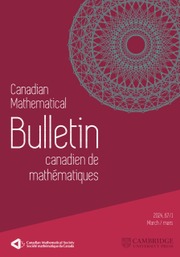No CrossRef data available.
Article contents
Compatibility of theta lifts and tempered condition
Part of:
Lie groups
Published online by Cambridge University Press: 21 June 2023
Abstract
In this note, assuming the nonvanishing result of explicit theta correspondence for the symplectic–orthogonal dual pair over quaternion algebra  $\mathbb {H}$, we show that, for metapletic–orthogonal dual pair over
$\mathbb {H}$, we show that, for metapletic–orthogonal dual pair over  $\mathbb {R}$ and the symplectic–orthogonal dual pair over quaternion algebra
$\mathbb {R}$ and the symplectic–orthogonal dual pair over quaternion algebra  $\mathbb {H}$, the theta correspondence is compatible with tempered condition by directly estimating the matrix coefficients, without using the classification theorem.
$\mathbb {H}$, the theta correspondence is compatible with tempered condition by directly estimating the matrix coefficients, without using the classification theorem.
MSC classification
Information
- Type
- Article
- Information
- Copyright
- © The Author(s), 2023. Published by Cambridge University Press on behalf of The Canadian Mathematical Society
References
Adams, J. and Barbasch, D., Genuine representation of the metaplectic group. Comp. Math. 113(1998), 23–66. https://doi.org/10.1023/A:1000450504919
CrossRefGoogle Scholar
Cowling, M., Haagerup, U., and Howe, R., Almost
 ${{L}}^2$
matrix coefficients
. J. Reine Angew. Math. 387(1988), 97–110. https://doi.org/10.1515/crll.1988.387.97
Google Scholar
${{L}}^2$
matrix coefficients
. J. Reine Angew. Math. 387(1988), 97–110. https://doi.org/10.1515/crll.1988.387.97
Google Scholar
Gan, W. T. and Ichino, A., On endoscopy and the refined Gross–Prasad conjecture for
 $\left({{SO}}_5,{{SO}}_4\right)$
. J. Inst. Math. Jussieu 10(2011), 235–324. https://doi.org/10.1017/S1474748010000198
CrossRefGoogle Scholar
$\left({{SO}}_5,{{SO}}_4\right)$
. J. Inst. Math. Jussieu 10(2011), 235–324. https://doi.org/10.1017/S1474748010000198
CrossRefGoogle Scholar
Gan, W. T. and Ichino, A.,
Formal degrees and local theta correspondence
. Invent. Math. 195(2014), 509–672. https://doi.org/10.1007/s00222-013-0460-5
CrossRefGoogle Scholar
Gan, W. T., Qiu, Y. N., and Takeda, S.,
The regularized Siegel–Weil formula (the second term identity) and the Rallis inner product formula
. Invent. Math. 198(2014), no. 3, 739–831. https://doi.org/10.1007/s00222-014-0509-0
CrossRefGoogle Scholar
He, H.,
Unitary representations and theta correspondence for type I classical groups
. J. Funct. Anal. 199(2003), no. 1, 92–121. https://doi.org/10.1016/S0022-1236(02)00170-2
CrossRefGoogle Scholar
He, H.,
Composition of theta correspondences
. Adv. Math. 190(2005), 225–263. https://doi.org/10.1016/j.aim.2004.01.001
CrossRefGoogle Scholar
Howe, R.,
Transcending invariant theory
. J. Amer. Math. Soc. 2(1989), no. 3, 535–552. https://doi.org/10.1090/S0894-0347-1989-0985172-6
CrossRefGoogle Scholar
Ichino, A.,
Theta lifting for tempered representations of real unitary groups
. Adv. Math. 398(2022), 108188.CrossRefGoogle Scholar
Ichino, A. and Ikeda, T.,
On the periods of automorphic forms on special orthogonal groups and the Gan–Gross–Prasad conjecture
. Geom. Funct. Anal. 19(2010), 1378–1425. https://doi.org/10.1007/S00039-009-0040-4
CrossRefGoogle Scholar
Lee, S. T. and Zhu, C. B.,
Degenerate principal series and local theta correspondence
. Trans. Amer. Math. Soc. 350(1998), no. 12, 5017–5046. https://doi.org/10.1090/S0002-9947-98-02036-4
CrossRefGoogle Scholar
Li, J., Paul, A., Tan, E., and Zhu, C., The explicit duality correspondence of
 $\left({Sp}\left({p},{q}\right),{{O}}^{\ast}\left(2{n}\right)\right)$
. J. Funct. Anal. 200(2003), 71–100.CrossRefGoogle Scholar
$\left({Sp}\left({p},{q}\right),{{O}}^{\ast}\left(2{n}\right)\right)$
. J. Funct. Anal. 200(2003), 71–100.CrossRefGoogle Scholar
Li, J. S.,
Singular unitary representations of classical groups
. Invent. Math. 97(1989), 237–255. https://doi.org/10.1007/BF01389041
CrossRefGoogle Scholar
Sun, B.,
Bounding matrix coefficients for smooth vectors of tempered representations
. Proc. Amer. Math. Soc. 137(2009), no. 1, 353–357. https://doi.org/10.1090/S0002-9939-08-09598-1
CrossRefGoogle Scholar
Trèvres, F., Topological vector spaces, distributions and kernels. Academic Press, New York, 1967. https://doi.org/10.1112/BLMS/1.3.444
Google Scholar
Varadarajan, V. S., Harmonic analysis on real reductive groups. Lecture Notes in Mathematics, 576, Springer, Berlin–Heidelberg, 1977. https://doi.org/10.1007/BF01390004
CrossRefGoogle Scholar
Wallach, N. R., Real reductive groups I. Pure and Applied Mathematics, 132, Academic Press, Boston, MA, 1988.Google Scholar
Wallach, N. R., Real reductive groups II. Pure and Applied Mathematics, 132, Academic Press, Boston, MA, 1992. https://doi.org/10.1016/0378-4754(92)90088-x
Google Scholar
Xue, H., Bessel model for real unitary groups: the tempered case. Duke Math. J. 172(2023), no. 5, 995–1031.Google Scholar


